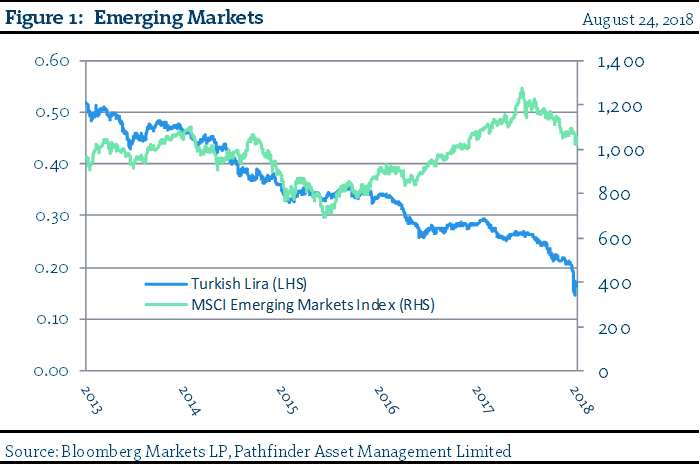Recap & Outlook: Emerging Markets… Why do we care?
In the last Outlook, we wrote about the businesses we invested in and how they and the rest of the North American economy looked quite healthy. As we wrote about those fundamentals, concern surrounding the economic situation in Turkey and potential for contagion began to dominate financial headlines.
- US and Turkey (NATO allies) relations deteriorated over a political issue involving a US evangelical pastor Turkey accuses of assisting with an attempted coup in 2016. US sanctions, tariffs and related Turkish reaction, caused the Turkish Lira to drop 25% over the weekend and 45% year to date.
- Turkey is a big borrower in $US, which, given the substantial drop in their currency, leads to concern that Turkey would not be able to repay what it had previously borrowed. This could mean that their economy would suffer and, more immediately, any bank or investor that had lent or invested capital in the county, either to governments or to companies, would have their assets impaired. This is a common theme in emerging market countries.

- European banks have lent to Turkey and a number of North American companies have Turkish sales exposure. This, along with the general removal of liquidity by the US Federal Reserve, caused contagion concerns which riled currency, fixed income and equity markets globally, with particular focus on emerging markets.
- I am getting the feeling of déjà vu because this same thing happened in 1997. Over-indebted emerging market countries held loans denominated in non-local currencies which became a problem when the Thai Baht devalued. Imagine if your mortgage payment (or corporate loan) suddenly increased 25% because the dollar dropped. That would be a tough pill to swallow. In developed markets, companies have access to sophisticated markets so they do not have to worry about foreign currency borrowing but this is not the case in other parts of the world.
“This means that” we are watching emerging markets very closely. We essentially have no exposure to this part of the world but have in the past. For the right price, we would consider adding it again. Please take a moment to review the trade report sheets for Microsoft Corporation (MSFT US) and Alphabet Inc (GOOG US). They are great companies, but we have reduced our weights due to valuation and because they have grown to be too large in our various mandates.
National Instrument 31-103 requires registered firms to disclose information that a reasonable investor would expect to know, including any material conflicts with the firm or its representatives. Doug Johnson and/or Pathfinder Asset Management Limited are an insider of companies periodically mentioned in this report. Please visit www.paml.ca for full disclosures.
*All returns are time weighted and net of investment management fees. Returns from the Pathfinder Partners’ Fund and Partners’ Real Return Plus Fund are presented based on the masters series of each fund. The Pathfinder Core: Equity Portfolio and The Pathfinder Core: High Income Portfolio are live accounts. These are actual accounts owned by the Pathfinder Chairman (Equity) and client (High Income) which contain no legacy positions, cash flows or other Pathfinder investment mandates or products. Monthly inception dates for each fund and portfolio are as follows: Pathfinder Core: Equity Portfolio (January 2011), Pathfinder Core: High Income Portfolio (October 2012) Partners’ Fund (April 2011), Partners’ Real Return Plus Fund (April, 2013), and Partners’ Core Plus Fund (November 2014).
Pathfinder Asset Management Limited (PAML) and its affiliates may collectively beneficially own in excess of 10% of one or more classes of the issued and outstanding equity securities mentioned in this newsletter. This publication is intended only to convey information. It is not to be construed as an investment guide or as an offer or solicitation of an offer to buy or sell any of the securities mentioned in it. The author has taken all usual and reasonable precautions to determine that the information contained in this publication has been obtained from sources believed to be reliable and that the procedures used to summarize and analyze such information are based on approved practices and principles in the investment industry. However, the market forces underlying investment value are subject to sudden and dramatic changes and data availability varies from one moment to the next. Consequently, neither the author nor PAML can make any warranty as to the accuracy or completeness of information, analysis or views contained in this publication or their usefulness or suitability in any particular circumstance. You should not undertake any investment or portfolio assessment or other transaction on the basis of this publication, but should first consult your portfolio manager, who can assess all relevant particulars of any proposed investment or transaction. PAML and the author accept no liability of any kind whatsoever or any damages or losses incurred by you as a result of reliance upon or use of this publication.